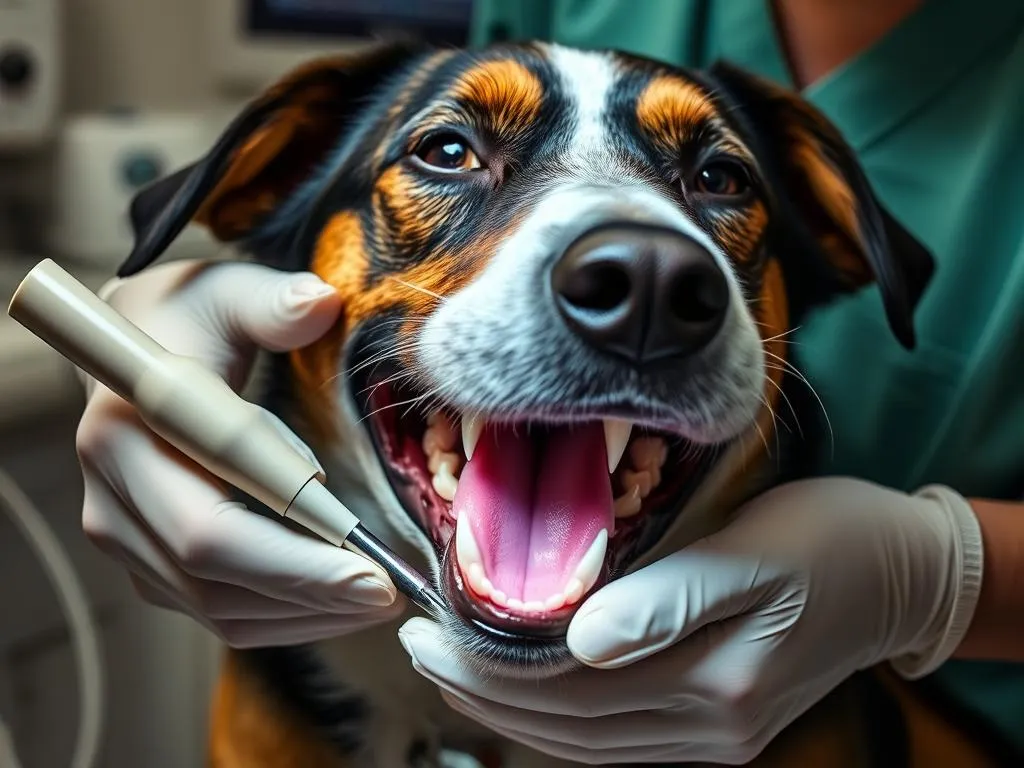
Introduction
As a responsible dog owner, you understand the importance of regular veterinary care for your furry friend. Just like humans, dogs can suffer from various health issues, many of which are linked to poor dental hygiene. Without proper dental care, dogs can develop serious problems such as periodontal disease and tooth decay, which can ultimately affect their overall health and well-being.
Dental health is a critical aspect of your dog’s health care routine. Keeping your dog’s teeth clean and healthy is essential not only for their mouth but also for their heart, liver, and kidneys. In many cases, professional anesthesia dog teeth cleaning is necessary to ensure a thorough and effective cleaning. Understanding the role of anesthesia in these procedures can help alleviate concerns and enhance your dog’s dental health.
Understanding Dog Dental Health
Importance of Dental Health in Dogs
Dental health plays a vital role in your dog’s overall health. Poor dental hygiene can lead to tartar buildup, gum disease, and infections, which can cause pain and discomfort. These issues can also lead to systemic health problems as bacteria from the mouth can enter the bloodstream and affect vital organs. Regular dental care can prevent these issues and ensure your dog remains happy and healthy.
Common dental problems in dogs include:
– Periodontal disease: A progressive disease that affects the tissues surrounding the teeth, leading to tooth loss if left untreated.
– Tooth decay: A condition where the tooth enamel deteriorates, often resulting in pain or infection.
Signs of Dental Issues
It’s essential to be vigilant and recognize the signs of dental problems in your dog. Some common indicators include:
– Bad breath (halitosis): An obvious sign of dental issues, often caused by bacteria buildup.
– Difficulty eating or chewing: If your dog is hesitating to chew their food, it may indicate dental pain.
– Swollen or bleeding gums: Healthy gums should be pink and firm; any swelling or bleeding is a sign of trouble.
– Excessive drooling: This may occur if your dog is in pain or discomfort.
Routine Dental Care for Dogs
Routine dental care is crucial to maintaining your dog’s oral health. Recommended practices include:
– Brushing: Ideally, you should brush your dog’s teeth daily using toothpaste formulated for dogs.
– Dental chews: These can help reduce plaque and tartar buildup.
– Regular veterinary dental check-ups: Your veterinarian can perform thorough cleanings and check for any underlying issues.
The Role of Anesthesia in Dog Teeth Cleaning
What is Anesthesia?
Anesthesia is a medical treatment that prevents pain during surgical or dental procedures. In veterinary dentistry, different types of anesthesia can be used:
– Local anesthesia: Numbs a specific area but does not render the dog unconscious.
– Sedation: Calms the dog but may not provide complete pain relief.
– General anesthesia: Puts the dog into a deep sleep, ensuring they are completely unaware of the procedure.
The Need for Anesthesia During Teeth Cleaning
Performing dental cleaning without anesthesia dog teeth cleaning can be challenging and potentially dangerous. Dogs cannot sit still for the duration of the procedure, and they may experience pain or discomfort. A thorough cleaning requires the ability to access all areas of the mouth, including beneath the gums, which is only possible when the dog is under general anesthesia.
Certain cases necessitate anesthesia more than others, such as:
– Aggressive dogs: Anesthesia helps prevent potential injury to the dog or the staff.
– Extensive cleaning needed: If a dog has severe dental issues, anesthesia allows for a comprehensive cleaning and treatment.
Types of Anesthesia Used in Veterinary Dentistry
Veterinarians utilize various anesthetic agents, each with unique properties. Commonly used anesthetics include:
– Propofol: Provides quick onset and recovery, making it a popular choice for many procedures.
– Isoflurane: A gas anesthetic that allows for easy control of depth and rapid recovery.
Understanding the differences between sedation and general anesthesia is crucial. While sedation may be sufficient for minor procedures, general anesthesia is often necessary for comprehensive dental cleanings to ensure the dog’s comfort and safety.
The Anesthesia Process for Dog Teeth Cleaning
Pre-Anesthetic Evaluation
Before any procedure involving anesthesia, a thorough health assessment is crucial. This evaluation typically includes:
– Health history: A detailed history of your dog’s health, including any pre-existing conditions.
– Blood tests: Routine blood work helps assess organ function and ensure your dog is fit for anesthesia.
The Anesthesia Procedure
The anesthesia process involves several steps:
1. Pre-anesthetic medication: Sedatives may be administered to calm the dog before the procedure.
2. Induction: The anesthetic agent is given, causing the dog to lose consciousness.
3. Monitoring: During the procedure, vital signs such as heart rate, respiratory rate, and oxygen levels are closely monitored to ensure the dog’s safety.
Post-Anesthesia Care
After the procedure, your dog will be monitored until they wake up from anesthesia. Recovery can vary, but signs to watch for include:
– Disorientation or grogginess: It’s normal for dogs to be a bit out of sorts after waking.
– Nausea or vomiting: Some dogs may experience mild nausea, but this should resolve quickly.
– Behavior changes: Keep an eye on your dog as they recover, and contact your veterinarian if anything seems off.
Follow-up appointments are essential to ensure your dog’s recovery is on track and to address any concerns.
Risks and Considerations
Potential Risks of Anesthesia
Like any medical procedure, anesthesia carries some risks. Potential side effects include:
– Allergic reactions: Some dogs may have adverse reactions to anesthetic agents.
– Respiratory complications: These can arise, particularly in dogs with pre-existing respiratory issues.
– Cardiovascular effects: Anesthesia can affect heart rate and blood pressure, especially in older dogs or those with heart conditions.
Specific breeds may also be at higher risk due to their physical characteristics. For example, brachycephalic breeds (like Bulldogs and Pugs) may face increased risks during anesthesia due to their narrow airways.
Mitigating Risks
Veterinarians take various precautions to mitigate the risks associated with anesthesia:
– Risk assessment: A thorough assessment helps identify any potential issues before the procedure.
– Qualified professionals: Choosing a veterinarian with experience in dental procedures and anesthesia is critical.
– Open communication: Discuss any concerns or questions with your veterinarian prior to the procedure.
Cost Considerations
Understanding the Costs Involved
The cost of anesthesia dog teeth cleaning can vary widely based on several factors, including:
– Location: Prices may differ depending on your geographic area and the clinic.
– Complexity of the procedure: More extensive cleanings or additional treatments will increase costs.
– Veterinary fees: Each clinic may have different pricing structures for anesthesia and dental cleaning.
On average, pet owners can expect to pay anywhere from $200 to $800 for a dental cleaning that includes anesthesia, but prices can vary.
Long-Term Cost Benefits of Dental Care
Investing in your dog’s dental health can save you money in the long run. Regular dental care helps prevent serious conditions that could lead to expensive treatments. By prioritizing your dog’s dental hygiene, you can avoid costly surgeries or medications in the future.
Conclusion
Maintaining your dog’s dental health is essential for their overall well-being, and understanding the role of anesthesia in dog teeth cleaning is an important part of that care. Regular dental check-ups, proper hygiene practices, and timely treatments can significantly enhance your dog’s quality of life. As a responsible pet owner, it’s crucial to prioritize dental health and engage in open discussions with your veterinarian about the best practices for your furry friend.
FAQs
Common Questions About Anesthesia and Dog Teeth Cleaning
Is anesthesia safe for my dog?
Yes, when administered by a qualified veterinarian, anesthesia is generally safe for dogs. Pre-anesthetic evaluations help minimize risks.
How often should my dog have teeth cleaning?
Most dogs should have a professional dental cleaning at least once a year. However, some may require more frequent cleanings based on their dental health.
What are the signs my dog needs dental cleaning?
Signs to watch for include bad breath, difficulty eating, swollen gums, and excessive drooling. If you notice any of these signs, consult your veterinarian for an evaluation.
By understanding the importance of dental health and the role of anesthesia in dental cleanings, you can take proactive steps to ensure your dog remains healthy and happy for years to come.









